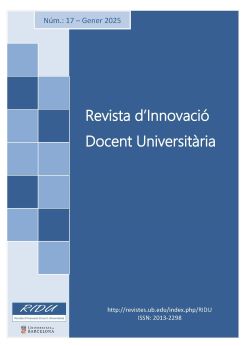Choreographies of the gaze. A research-creation project in dance
DOI:
https://doi.org/10.1344/RIDU2025.17.8Keywords:
Dance, Research, Creation, Performance, CinemaAbstract
Artistic research-creation is an emerging research program in the academic field, of interest for the production of knowledge, the generation of discourse, education and the communication, and the dissemination of contemporary performing arts practices.
In the field of dance, research-creation acquires special relevance from the moment in its practice goes beyond the narrow disciplinary frameworks and conventions of performing arts to come into contact with the socio-historical and cultural contexts in which it operates.
On the other hand, research-creation addresses the processes and interrelations that occur between the subject and the object of the research, involving the body and the sensorial, socio-affective, and intersubjective systems of the participants.
The focus on processes, as opposed to the products of creation, is not merely a technical, methodological, or aesthetic option, but represents a thought in action whose performativity involves political, ethical, and discursive questions. These questions relate to the way of configuring and defining the objectives and interests of the research, the values involved, and the positioning of the subject in relation to the tensions and conflicts present in the contexts in which it lives, and in relation to which it is committed and acts.
And it is precisely this positioning that makes research-creation a project of knowledge and social transformation, and of knowledge and transformation of the subject of the research itself, by making sensitive and thinkable, as well as ethically and politically approachable, questions that, for one reason or another, have been relegated and excluded from the social space and, consequently, from the possibility of dissent, debate, and public deliberation.
References
Appadurai, A. (1991). La vida social de las cosas. Perspectiva cultural de las mercancías. Grijalbo.
Bal, M. (2003). El esencialismo visual y el objeto de los estudios visuales. Revista de Estudios Visuales, 2, 11-49.
Bal, M. (2009). Conceptos viajeros en las humanidades. CENDEAC.
Barthes, R. (1984). Le bruissement de la langue. Éditions du Seuil.
Bazin, A. (2008). ¿Qué es el cine? Rialp.
Borgdorff, H. (2009). Artistic research within the fields of science. Sensuous Knowledge 6 Knowledge, Bergen National Academy of the Arts.
Code, L. (1991). What can she know? Feminist theory and the construction of knowledge. Cornell University Press.
Deleuze, G. (2001). La imagen-movimiento. Estudios sobre el cine 1. Paidós.
Deleuze, G. (2011). Los signos del movimiento y el tiempo. Cactus.
Deren, M. (1946). An anagram of ideas on art, form and film. The Alicat Book Shop Press.
Fabbri, P. (1995). Campo de maniobras didácticas. En J. L. Rodríguez (Comp.), Educación y comunicación. Paidós.
Godínez, G. L. (2014). Cuerpo: efectos escénicos y literarios: Pina Bausch. Tesis de Doctorado, Departamento de Filología española, clásica y árabe, Universidad de Las Palmas de Gran Canaria http://hdl.handle.net/10553/13024
Hernández, F. (2006). Campos, temas y metodologías para la investigación relacionada con las artes. En F. Hernández, M. C Gómez Muntané, y H. Pérez López (Coords.), Bases para un debate sobre investigación científica (pp. 9-49). Ministerio de Educación y Ciencia.
Foucault, M. (2009). Nacimiento de la biopolítica. Curso del Collège de France (1978-1979). Akal.
Lorente, J. I. (2015). Investigación-acción y aprendizaje basado en proyectos en las enseñanzas de postgrado en artes escénicas. RIDU. Revista d’Innovació Docent Universitària, 7, 97-115. https://doi.org/10.1344/RIDU2015.7.10
Lorente, J. I. (2020a). Coreografía de la mirada. El cine piensa la danza. En A. Mª. Díaz (Coord.), Comunicar en danza (pp. 37-58). Ed. Libargo.
Lorente, J. I. (2020b). Coreografíar la experiencia urbana: RSVP cycles, de Anna y Lawrence Halprin. AusArt, 8(2), 89-99. https://doi.org/10.1387/ausart.22042
Lefebvre, H. (1992). Éléments de rythmanalyse. Editions Syllepse.
Manning, E., y Massumi, B. (2014). Thought in the act. Passages in the ecology of experience. Unniversity of Minnesota Press.
Rancière, J. (2007). El maestro ignorante. Cinco lecciones sobre la emancipación intelectual. Libros del Zorzal.
Rancière, J. (2010). El espectador emancipado. Manantial.
Rancière, J. (2014). El reparto de lo sensible: estética y política. Prometeo Libros.
Sánchez, J. A. (2007). Prácticas de lo real en la escena contemporánea. Visor Libros.
Simmel, G. (1903). Las grandes urbes y la vida del espíritu. Cuadernos Políticos, 45, México D.F., ed. Era, enero-marzo de 1986, 5-10.
Van Manem, M. (2003). Investigación educativa y experiencia vivida. Idea Books.
Downloads
Published
Issue
Section
License
Copyright (c) 2025 José Ignacio Lorente

This work is licensed under a Creative Commons Attribution 4.0 International License.
Authors whishing to publish in this journal agree to the following conditions:
- The author or author retain copyright and grants the journal the right of first publication of the paper.
- The texts will be published under license "Reconocimiento Creative Commons 4.0 España", which allows to share, distribute, reproduce and the public communication of the paper, as long as the name of the author or authors and the journal are clearly stated.







